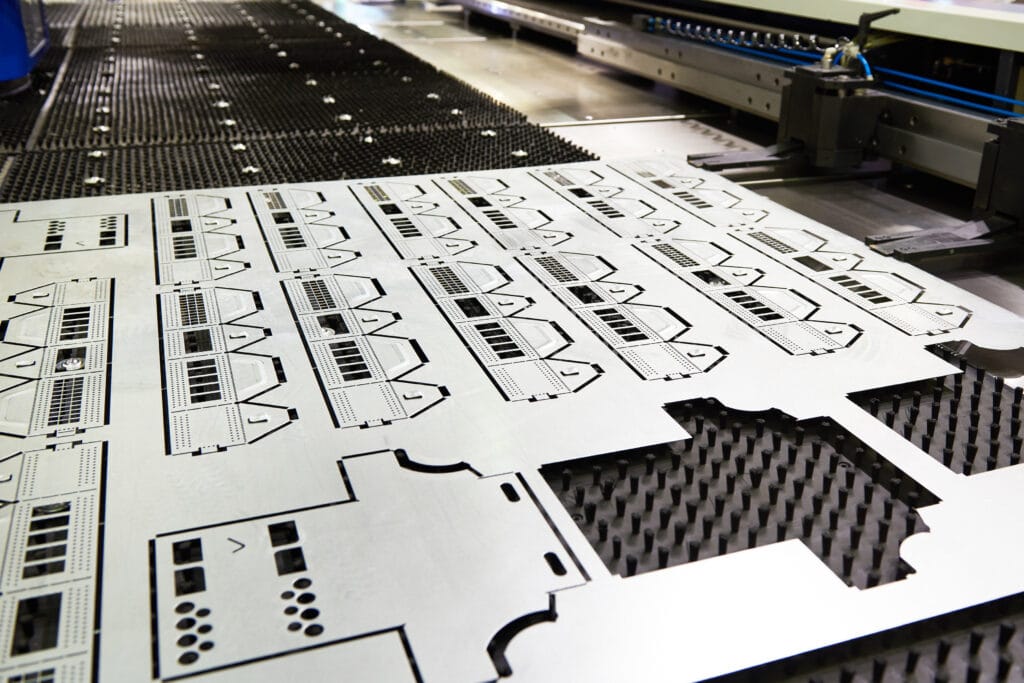In our shop, we manufacture a lot of parts in either carbon or stainless steel. They are among the two most popular metal options on the market, and there are great reasons to use either of these materials.
While they might sound like two options of the same material, steel, their benefits and drawbacks vary wildly. In the following sections, we’ll explain these differences and show you which material is right for your next project.
What Is Stainless Steel?
Stainless steel is an iron-based alloy of steel that is comprised of at least 10% chromium, which is a corrosion-resisting element. With chromium included, stainless steel creates a passive layer on the outside of every part that prevents rust.
Plenty of stainless steel alloys also contain varying levels of nickel, molybdenum, and nitrogen that make the parts further corrosion-resistant while tweaking some of the mechanical properties, such as durability and manufacturability.
Common grades of stainless steel are 304, which is the basic “go-to” alloy for plenty of companies. It’s easy to work with and offers great corrosion resistance. For more resistance to chemicals and rust, you can use 316, which has more molybdenum.
Designing with stainless steel sheet metal in mind?
Grab our free Sheet Metal Fabrication Guide to learn how to avoid common pitfalls and ensure precise, durable parts.
Pros and Cons of Stainless Steel
As a material, there are a lot of pros and cons of using stainless steel. Here are some of the more common examples:
- Better corrosion resistance. As expected, stainless steel parts have better corrosion resistance, especially for parts exposed to moisture or chemicals.
- Very little upkeep or finishing is needed. In many cases, you won’t need a finishing step or coating added to your stainless steel parts, which reduces the time and money required to fabricate parts.
- Durable and works well in demanding applications. Stainless steel parts are often lauded for their ability to last a long time before failing, especially in applications with high temperatures, forces, and cyclic loading.
- Higher cost. The downside is that raw stainless steel costs more than raw carbon steel.
- More difficult to machine and weld. In addition, machining and welding stainless steel can be more complicated than working with carbon steel, and our team has to use higher-quality tooling to ensure it doesn’t wear out as quickly. However, Rapid Axis has extensive experience with stainless steel, so no project is too complex for our team to handle.
What Is Carbon Steel?
Carbon steel, also called “mild steel” or just plainly, “steel”, is an alloy of steel that uses very little carbon, chromium, nickel, or other corrosion-resistant elements. On paper, that is the only difference between carbon steel and stainless, but it can completely change how functional a part is.
Since carbon steel isn’t corrosion-resistant, you can expect to find rust on all of your parts over time, especially in more humid environments or applications that are exposed to water or chemicals.
Keep in mind, corrosion isn’t just an eyesore. Over time, rust can create pitting or small holes and divots on parts that eventually expand and create sizable holes in your parts. This leads to part failure and mechanical complications.

Pros and Cons of Carbon Steel
This lack of corrosion resistance accounts for a few major pros and cons of using carbon steel in an industrial application:
- A strong and affordable option. With the same basic strength of stainless steel, carbon steel offers a lot of the same benefits at a lower price.
- Easier to machine and weld. In addition, carbon steel is easier to machine and weld, which saves time and money in the machine shop.
- Requires finishing steps to avoid corrosion. As a rule of thumb, you always want to powder coat or plate your carbon steel parts, which can create the same level of corrosion resistance as stainless steel parts. This adds complexity to your project orders, but we can handle all of these finishing steps at Rapid Axis.
- Not ideal for harsh environments. Without a powder coat, carbon steel is a poor choice for use in any harsh environment. It will quickly rust and degrade, eventually leading to failures.
Carbon Steel vs Stainless Steel
Is carbon steel or stainless steel the better option for your next project? It depends on what you’re looking for.
To put it very simply, stainless steel is the better option if you want to avoid rust and have a more durable part at the expense of a higher cost. Carbon steel is a less expensive option that is easier to machine and weld, but it will fail over time.
As a third option, you can consider powder-coated carbon steel. It offers all the benefits of stainless steel, and (depending on the size, complexity, and quantity of your parts) can be less expensive than stainless.
Both steel options are great, and they are used across the medical, food, aerospace, structural, and automotive industries.
Conclusion
Choosing between carbon and stainless steel can make or break your operation. Choosing untreated carbon steel in a high-moisture environment can lead to disaster, and choosing stainless steel for a very mild application could mean wasting your time making more expensive parts than you need. We also understand that this decision can be complicated, so please reach out to our team and we’ll help you pick the right material for your next project. Contact us today to learn more about our CNC machining and sheet metal fabrication services, get a free quote, and find a long-term manufacturing partner in Rapid Axis.

